University Study: Impact of Sociological Issues on Happiness
VerifiedAdded on 2023/04/24
|30
|7920
|274
Essay
AI Summary
This essay investigates the impact of various sociological issues on individual happiness, also known as subjective well-being (SWB). It begins by exploring the concept of a good life and how it relates to happiness, referencing the works of Hobbes and Locke. The essay delves into factors such as income, education, employment, age, and gender, analyzing their correlation with happiness. It discusses the Easterlin Paradox, examining whether increased income leads to increased happiness, and presents different theories, including adaptation theory and relative income theory, to explain this phenomenon. The essay also examines the impact of education, employment status, age, health, and gender on happiness levels, supported by data from European countries. The research aims to understand the complex interplay between these sociological elements and their influence on an individual's overall well-being and quality of life, concluding with a comprehensive analysis of the importance of achieving a high standard of living for people globally.
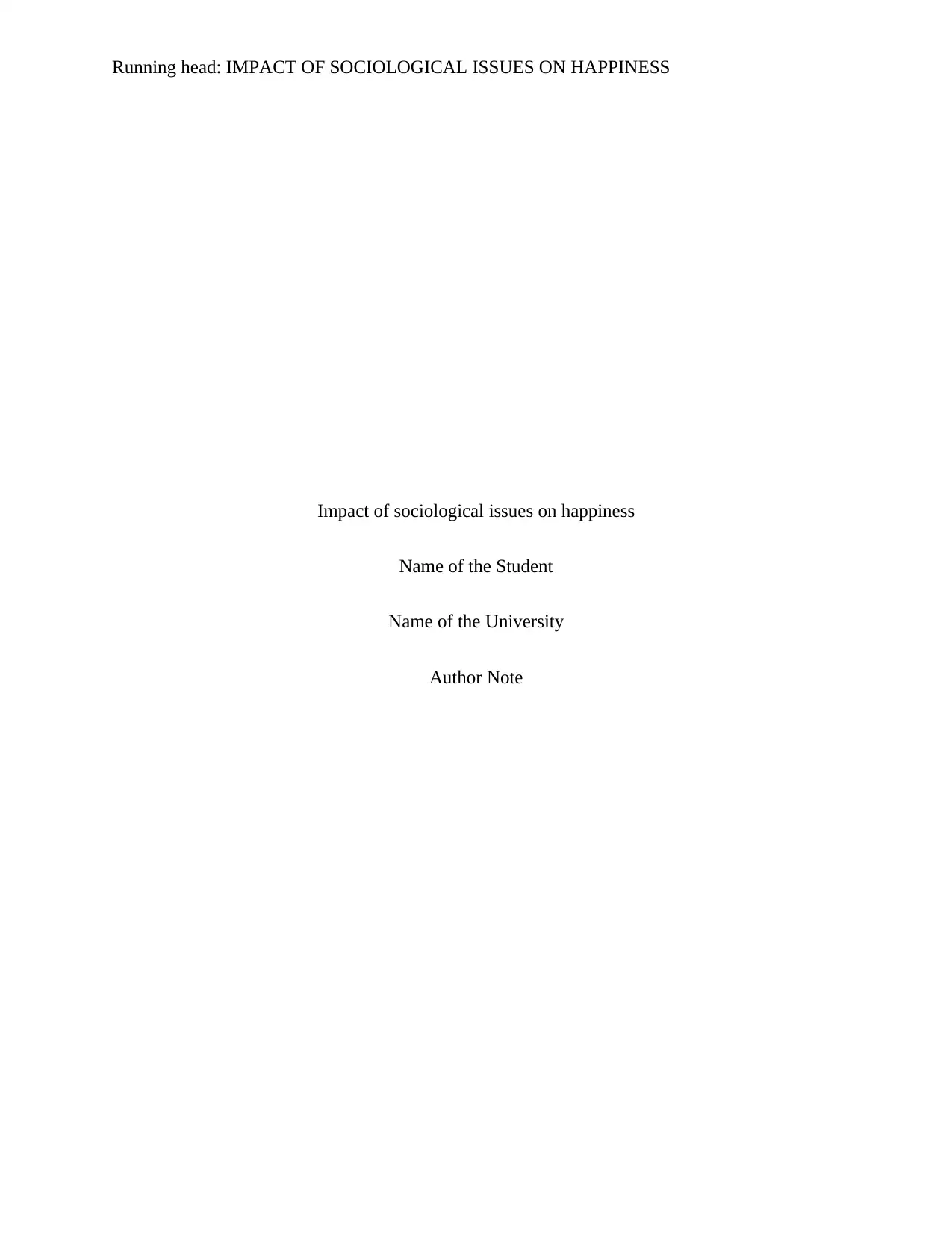
Running head: IMPACT OF SOCIOLOGICAL ISSUES ON HAPPINESS
Impact of sociological issues on happiness
Name of the Student
Name of the University
Author Note
Impact of sociological issues on happiness
Name of the Student
Name of the University
Author Note
Paraphrase This Document
Need a fresh take? Get an instant paraphrase of this document with our AI Paraphraser
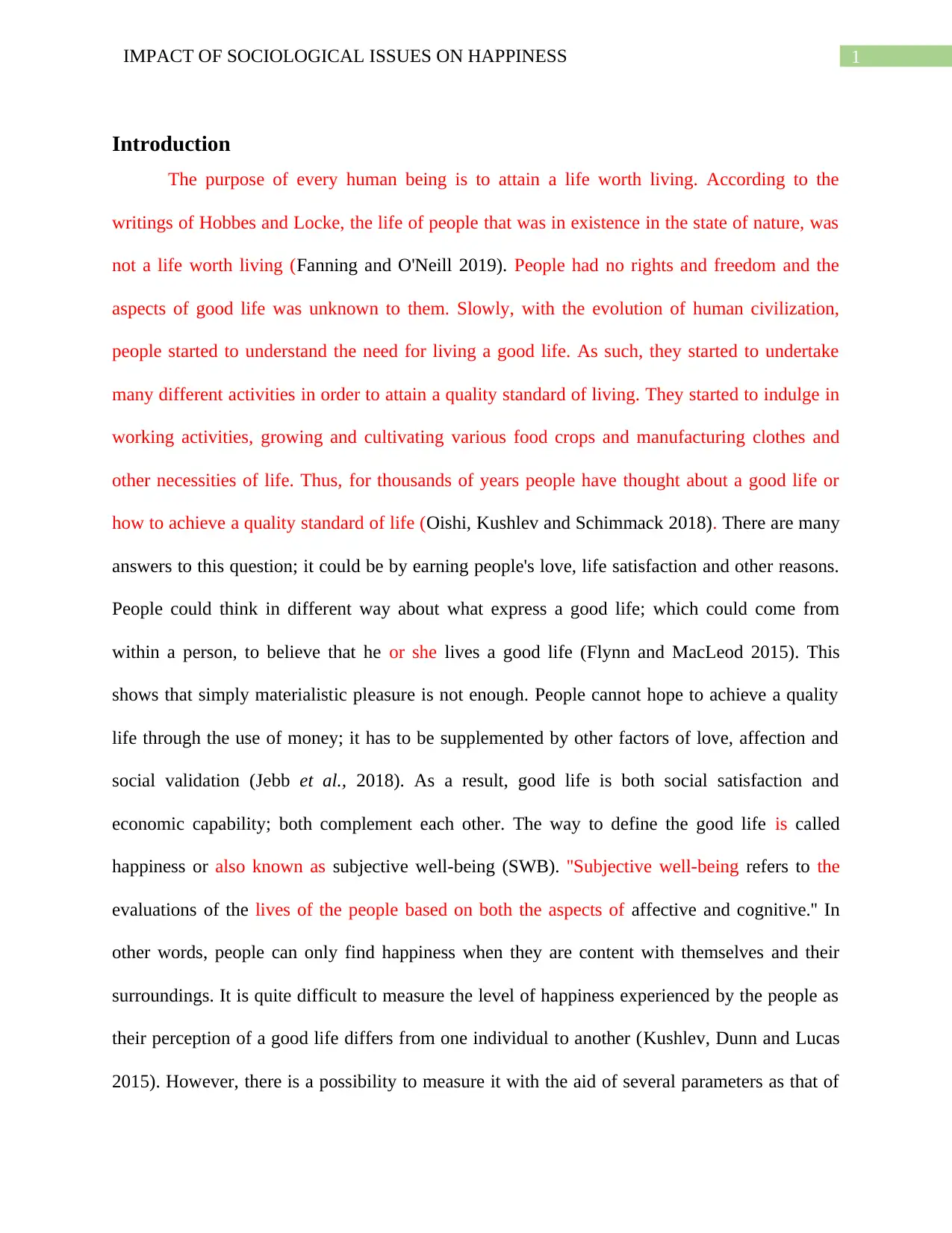
1IMPACT OF SOCIOLOGICAL ISSUES ON HAPPINESS
Introduction
The purpose of every human being is to attain a life worth living. According to the
writings of Hobbes and Locke, the life of people that was in existence in the state of nature, was
not a life worth living (Fanning and O'Neill 2019). People had no rights and freedom and the
aspects of good life was unknown to them. Slowly, with the evolution of human civilization,
people started to understand the need for living a good life. As such, they started to undertake
many different activities in order to attain a quality standard of living. They started to indulge in
working activities, growing and cultivating various food crops and manufacturing clothes and
other necessities of life. Thus, for thousands of years people have thought about a good life or
how to achieve a quality standard of life (Oishi, Kushlev and Schimmack 2018). There are many
answers to this question; it could be by earning people's love, life satisfaction and other reasons.
People could think in different way about what express a good life; which could come from
within a person, to believe that he or she lives a good life (Flynn and MacLeod 2015). This
shows that simply materialistic pleasure is not enough. People cannot hope to achieve a quality
life through the use of money; it has to be supplemented by other factors of love, affection and
social validation (Jebb et al., 2018). As a result, good life is both social satisfaction and
economic capability; both complement each other. The way to define the good life is called
happiness or also known as subjective well-being (SWB). ''Subjective well-being refers to the
evaluations of the lives of the people based on both the aspects of affective and cognitive.'' In
other words, people can only find happiness when they are content with themselves and their
surroundings. It is quite difficult to measure the level of happiness experienced by the people as
their perception of a good life differs from one individual to another (Kushlev, Dunn and Lucas
2015). However, there is a possibility to measure it with the aid of several parameters as that of
Introduction
The purpose of every human being is to attain a life worth living. According to the
writings of Hobbes and Locke, the life of people that was in existence in the state of nature, was
not a life worth living (Fanning and O'Neill 2019). People had no rights and freedom and the
aspects of good life was unknown to them. Slowly, with the evolution of human civilization,
people started to understand the need for living a good life. As such, they started to undertake
many different activities in order to attain a quality standard of living. They started to indulge in
working activities, growing and cultivating various food crops and manufacturing clothes and
other necessities of life. Thus, for thousands of years people have thought about a good life or
how to achieve a quality standard of life (Oishi, Kushlev and Schimmack 2018). There are many
answers to this question; it could be by earning people's love, life satisfaction and other reasons.
People could think in different way about what express a good life; which could come from
within a person, to believe that he or she lives a good life (Flynn and MacLeod 2015). This
shows that simply materialistic pleasure is not enough. People cannot hope to achieve a quality
life through the use of money; it has to be supplemented by other factors of love, affection and
social validation (Jebb et al., 2018). As a result, good life is both social satisfaction and
economic capability; both complement each other. The way to define the good life is called
happiness or also known as subjective well-being (SWB). ''Subjective well-being refers to the
evaluations of the lives of the people based on both the aspects of affective and cognitive.'' In
other words, people can only find happiness when they are content with themselves and their
surroundings. It is quite difficult to measure the level of happiness experienced by the people as
their perception of a good life differs from one individual to another (Kushlev, Dunn and Lucas
2015). However, there is a possibility to measure it with the aid of several parameters as that of
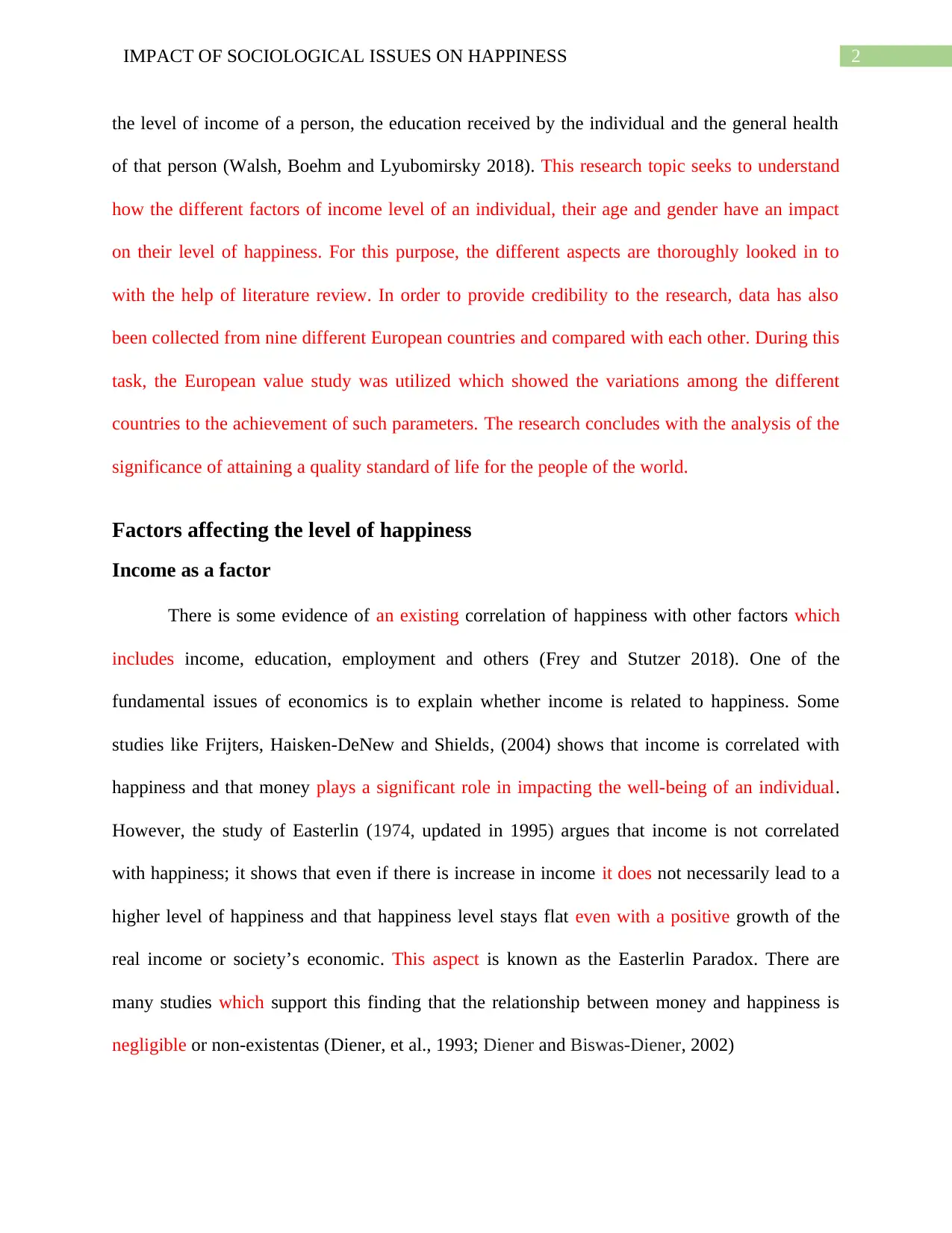
2IMPACT OF SOCIOLOGICAL ISSUES ON HAPPINESS
the level of income of a person, the education received by the individual and the general health
of that person (Walsh, Boehm and Lyubomirsky 2018). This research topic seeks to understand
how the different factors of income level of an individual, their age and gender have an impact
on their level of happiness. For this purpose, the different aspects are thoroughly looked in to
with the help of literature review. In order to provide credibility to the research, data has also
been collected from nine different European countries and compared with each other. During this
task, the European value study was utilized which showed the variations among the different
countries to the achievement of such parameters. The research concludes with the analysis of the
significance of attaining a quality standard of life for the people of the world.
Factors affecting the level of happiness
Income as a factor
There is some evidence of an existing correlation of happiness with other factors which
includes income, education, employment and others (Frey and Stutzer 2018). One of the
fundamental issues of economics is to explain whether income is related to happiness. Some
studies like Frijters, Haisken-DeNew and Shields, (2004) shows that income is correlated with
happiness and that money plays a significant role in impacting the well-being of an individual.
However, the study of Easterlin (1974, updated in 1995) argues that income is not correlated
with happiness; it shows that even if there is increase in income it does not necessarily lead to a
higher level of happiness and that happiness level stays flat even with a positive growth of the
real income or society’s economic. This aspect is known as the Easterlin Paradox. There are
many studies which support this finding that the relationship between money and happiness is
negligible or non-existentas (Diener, et al., 1993; Diener and Biswas-Diener, 2002)
the level of income of a person, the education received by the individual and the general health
of that person (Walsh, Boehm and Lyubomirsky 2018). This research topic seeks to understand
how the different factors of income level of an individual, their age and gender have an impact
on their level of happiness. For this purpose, the different aspects are thoroughly looked in to
with the help of literature review. In order to provide credibility to the research, data has also
been collected from nine different European countries and compared with each other. During this
task, the European value study was utilized which showed the variations among the different
countries to the achievement of such parameters. The research concludes with the analysis of the
significance of attaining a quality standard of life for the people of the world.
Factors affecting the level of happiness
Income as a factor
There is some evidence of an existing correlation of happiness with other factors which
includes income, education, employment and others (Frey and Stutzer 2018). One of the
fundamental issues of economics is to explain whether income is related to happiness. Some
studies like Frijters, Haisken-DeNew and Shields, (2004) shows that income is correlated with
happiness and that money plays a significant role in impacting the well-being of an individual.
However, the study of Easterlin (1974, updated in 1995) argues that income is not correlated
with happiness; it shows that even if there is increase in income it does not necessarily lead to a
higher level of happiness and that happiness level stays flat even with a positive growth of the
real income or society’s economic. This aspect is known as the Easterlin Paradox. There are
many studies which support this finding that the relationship between money and happiness is
negligible or non-existentas (Diener, et al., 1993; Diener and Biswas-Diener, 2002)
⊘ This is a preview!⊘
Do you want full access?
Subscribe today to unlock all pages.

Trusted by 1+ million students worldwide
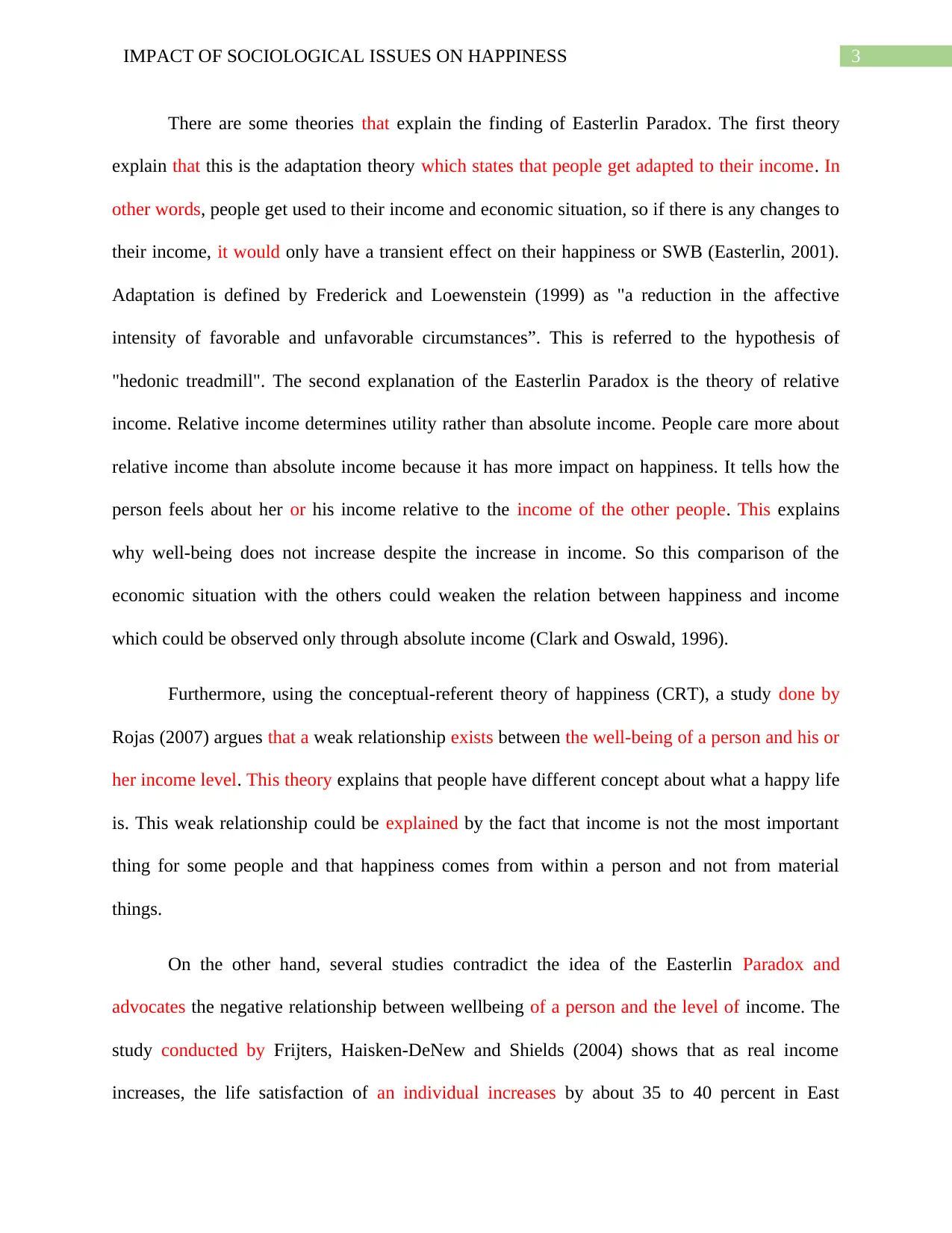
3IMPACT OF SOCIOLOGICAL ISSUES ON HAPPINESS
There are some theories that explain the finding of Easterlin Paradox. The first theory
explain that this is the adaptation theory which states that people get adapted to their income. In
other words, people get used to their income and economic situation, so if there is any changes to
their income, it would only have a transient effect on their happiness or SWB (Easterlin, 2001).
Adaptation is defined by Frederick and Loewenstein (1999) as "a reduction in the affective
intensity of favorable and unfavorable circumstances”. This is referred to the hypothesis of
"hedonic treadmill". The second explanation of the Easterlin Paradox is the theory of relative
income. Relative income determines utility rather than absolute income. People care more about
relative income than absolute income because it has more impact on happiness. It tells how the
person feels about her or his income relative to the income of the other people. This explains
why well-being does not increase despite the increase in income. So this comparison of the
economic situation with the others could weaken the relation between happiness and income
which could be observed only through absolute income (Clark and Oswald, 1996).
Furthermore, using the conceptual-referent theory of happiness (CRT), a study done by
Rojas (2007) argues that a weak relationship exists between the well-being of a person and his or
her income level. This theory explains that people have different concept about what a happy life
is. This weak relationship could be explained by the fact that income is not the most important
thing for some people and that happiness comes from within a person and not from material
things.
On the other hand, several studies contradict the idea of the Easterlin Paradox and
advocates the negative relationship between wellbeing of a person and the level of income. The
study conducted by Frijters, Haisken-DeNew and Shields (2004) shows that as real income
increases, the life satisfaction of an individual increases by about 35 to 40 percent in East
There are some theories that explain the finding of Easterlin Paradox. The first theory
explain that this is the adaptation theory which states that people get adapted to their income. In
other words, people get used to their income and economic situation, so if there is any changes to
their income, it would only have a transient effect on their happiness or SWB (Easterlin, 2001).
Adaptation is defined by Frederick and Loewenstein (1999) as "a reduction in the affective
intensity of favorable and unfavorable circumstances”. This is referred to the hypothesis of
"hedonic treadmill". The second explanation of the Easterlin Paradox is the theory of relative
income. Relative income determines utility rather than absolute income. People care more about
relative income than absolute income because it has more impact on happiness. It tells how the
person feels about her or his income relative to the income of the other people. This explains
why well-being does not increase despite the increase in income. So this comparison of the
economic situation with the others could weaken the relation between happiness and income
which could be observed only through absolute income (Clark and Oswald, 1996).
Furthermore, using the conceptual-referent theory of happiness (CRT), a study done by
Rojas (2007) argues that a weak relationship exists between the well-being of a person and his or
her income level. This theory explains that people have different concept about what a happy life
is. This weak relationship could be explained by the fact that income is not the most important
thing for some people and that happiness comes from within a person and not from material
things.
On the other hand, several studies contradict the idea of the Easterlin Paradox and
advocates the negative relationship between wellbeing of a person and the level of income. The
study conducted by Frijters, Haisken-DeNew and Shields (2004) shows that as real income
increases, the life satisfaction of an individual increases by about 35 to 40 percent in East
Paraphrase This Document
Need a fresh take? Get an instant paraphrase of this document with our AI Paraphraser
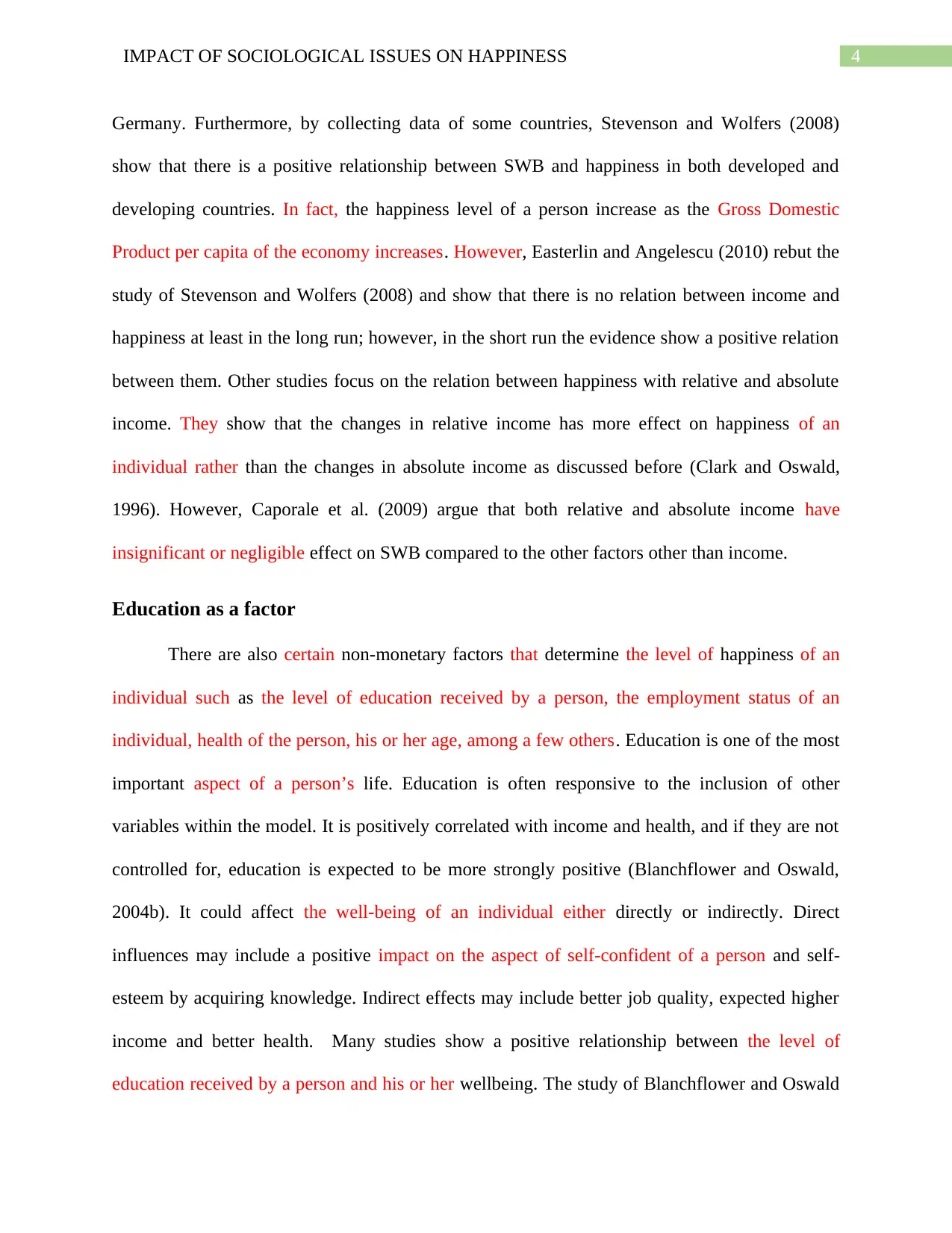
4IMPACT OF SOCIOLOGICAL ISSUES ON HAPPINESS
Germany. Furthermore, by collecting data of some countries, Stevenson and Wolfers (2008)
show that there is a positive relationship between SWB and happiness in both developed and
developing countries. In fact, the happiness level of a person increase as the Gross Domestic
Product per capita of the economy increases. However, Easterlin and Angelescu (2010) rebut the
study of Stevenson and Wolfers (2008) and show that there is no relation between income and
happiness at least in the long run; however, in the short run the evidence show a positive relation
between them. Other studies focus on the relation between happiness with relative and absolute
income. They show that the changes in relative income has more effect on happiness of an
individual rather than the changes in absolute income as discussed before (Clark and Oswald,
1996). However, Caporale et al. (2009) argue that both relative and absolute income have
insignificant or negligible effect on SWB compared to the other factors other than income.
Education as a factor
There are also certain non-monetary factors that determine the level of happiness of an
individual such as the level of education received by a person, the employment status of an
individual, health of the person, his or her age, among a few others. Education is one of the most
important aspect of a person’s life. Education is often responsive to the inclusion of other
variables within the model. It is positively correlated with income and health, and if they are not
controlled for, education is expected to be more strongly positive (Blanchflower and Oswald,
2004b). It could affect the well-being of an individual either directly or indirectly. Direct
influences may include a positive impact on the aspect of self-confident of a person and self-
esteem by acquiring knowledge. Indirect effects may include better job quality, expected higher
income and better health. Many studies show a positive relationship between the level of
education received by a person and his or her wellbeing. The study of Blanchflower and Oswald
Germany. Furthermore, by collecting data of some countries, Stevenson and Wolfers (2008)
show that there is a positive relationship between SWB and happiness in both developed and
developing countries. In fact, the happiness level of a person increase as the Gross Domestic
Product per capita of the economy increases. However, Easterlin and Angelescu (2010) rebut the
study of Stevenson and Wolfers (2008) and show that there is no relation between income and
happiness at least in the long run; however, in the short run the evidence show a positive relation
between them. Other studies focus on the relation between happiness with relative and absolute
income. They show that the changes in relative income has more effect on happiness of an
individual rather than the changes in absolute income as discussed before (Clark and Oswald,
1996). However, Caporale et al. (2009) argue that both relative and absolute income have
insignificant or negligible effect on SWB compared to the other factors other than income.
Education as a factor
There are also certain non-monetary factors that determine the level of happiness of an
individual such as the level of education received by a person, the employment status of an
individual, health of the person, his or her age, among a few others. Education is one of the most
important aspect of a person’s life. Education is often responsive to the inclusion of other
variables within the model. It is positively correlated with income and health, and if they are not
controlled for, education is expected to be more strongly positive (Blanchflower and Oswald,
2004b). It could affect the well-being of an individual either directly or indirectly. Direct
influences may include a positive impact on the aspect of self-confident of a person and self-
esteem by acquiring knowledge. Indirect effects may include better job quality, expected higher
income and better health. Many studies show a positive relationship between the level of
education received by a person and his or her wellbeing. The study of Blanchflower and Oswald
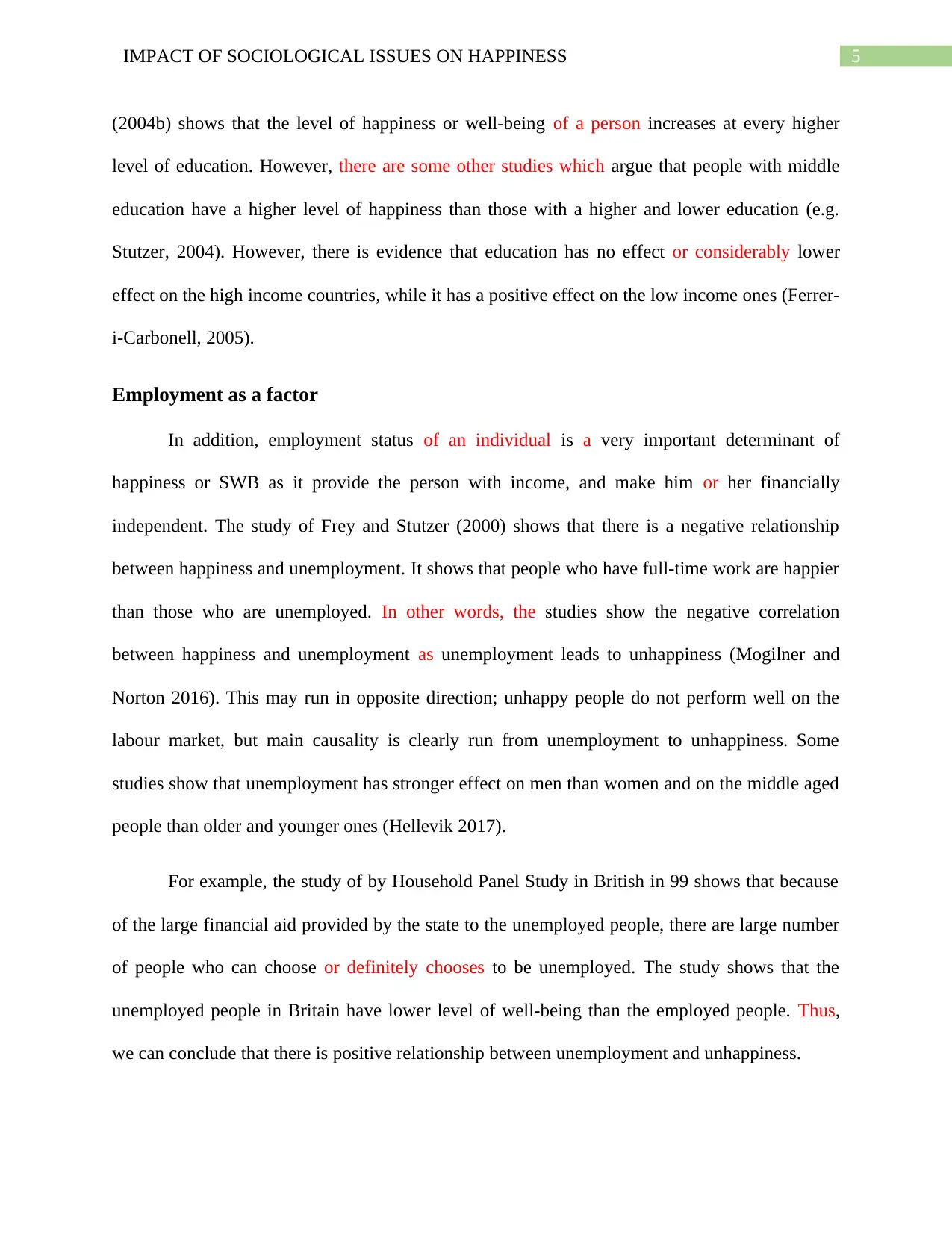
5IMPACT OF SOCIOLOGICAL ISSUES ON HAPPINESS
(2004b) shows that the level of happiness or well-being of a person increases at every higher
level of education. However, there are some other studies which argue that people with middle
education have a higher level of happiness than those with a higher and lower education (e.g.
Stutzer, 2004). However, there is evidence that education has no effect or considerably lower
effect on the high income countries, while it has a positive effect on the low income ones (Ferrer-
i-Carbonell, 2005).
Employment as a factor
In addition, employment status of an individual is a very important determinant of
happiness or SWB as it provide the person with income, and make him or her financially
independent. The study of Frey and Stutzer (2000) shows that there is a negative relationship
between happiness and unemployment. It shows that people who have full-time work are happier
than those who are unemployed. In other words, the studies show the negative correlation
between happiness and unemployment as unemployment leads to unhappiness (Mogilner and
Norton 2016). This may run in opposite direction; unhappy people do not perform well on the
labour market, but main causality is clearly run from unemployment to unhappiness. Some
studies show that unemployment has stronger effect on men than women and on the middle aged
people than older and younger ones (Hellevik 2017).
For example, the study of by Household Panel Study in British in 99 shows that because
of the large financial aid provided by the state to the unemployed people, there are large number
of people who can choose or definitely chooses to be unemployed. The study shows that the
unemployed people in Britain have lower level of well-being than the employed people. Thus,
we can conclude that there is positive relationship between unemployment and unhappiness.
(2004b) shows that the level of happiness or well-being of a person increases at every higher
level of education. However, there are some other studies which argue that people with middle
education have a higher level of happiness than those with a higher and lower education (e.g.
Stutzer, 2004). However, there is evidence that education has no effect or considerably lower
effect on the high income countries, while it has a positive effect on the low income ones (Ferrer-
i-Carbonell, 2005).
Employment as a factor
In addition, employment status of an individual is a very important determinant of
happiness or SWB as it provide the person with income, and make him or her financially
independent. The study of Frey and Stutzer (2000) shows that there is a negative relationship
between happiness and unemployment. It shows that people who have full-time work are happier
than those who are unemployed. In other words, the studies show the negative correlation
between happiness and unemployment as unemployment leads to unhappiness (Mogilner and
Norton 2016). This may run in opposite direction; unhappy people do not perform well on the
labour market, but main causality is clearly run from unemployment to unhappiness. Some
studies show that unemployment has stronger effect on men than women and on the middle aged
people than older and younger ones (Hellevik 2017).
For example, the study of by Household Panel Study in British in 99 shows that because
of the large financial aid provided by the state to the unemployed people, there are large number
of people who can choose or definitely chooses to be unemployed. The study shows that the
unemployed people in Britain have lower level of well-being than the employed people. Thus,
we can conclude that there is positive relationship between unemployment and unhappiness.
⊘ This is a preview!⊘
Do you want full access?
Subscribe today to unlock all pages.

Trusted by 1+ million students worldwide
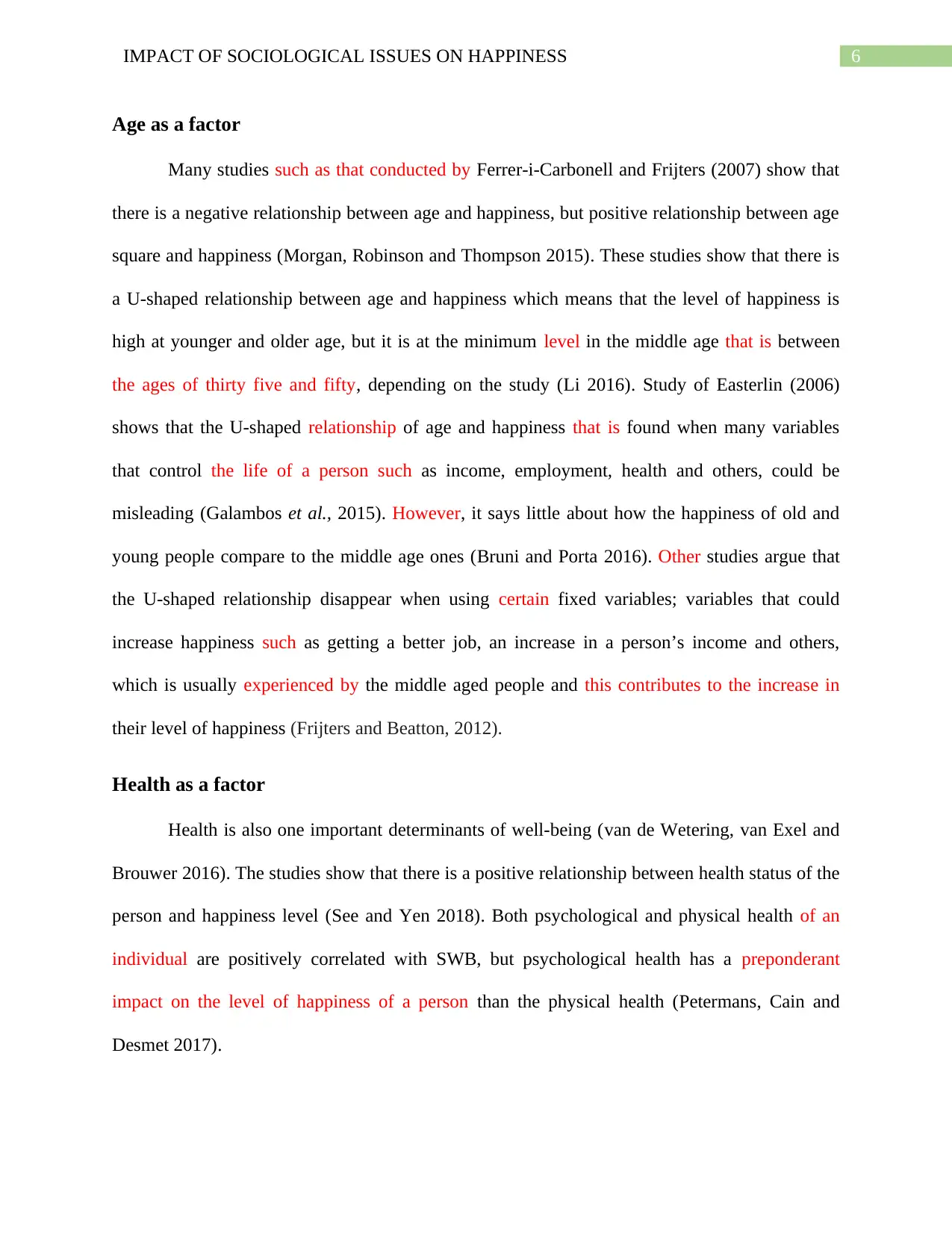
6IMPACT OF SOCIOLOGICAL ISSUES ON HAPPINESS
Age as a factor
Many studies such as that conducted by Ferrer-i-Carbonell and Frijters (2007) show that
there is a negative relationship between age and happiness, but positive relationship between age
square and happiness (Morgan, Robinson and Thompson 2015). These studies show that there is
a U-shaped relationship between age and happiness which means that the level of happiness is
high at younger and older age, but it is at the minimum level in the middle age that is between
the ages of thirty five and fifty, depending on the study (Li 2016). Study of Easterlin (2006)
shows that the U-shaped relationship of age and happiness that is found when many variables
that control the life of a person such as income, employment, health and others, could be
misleading (Galambos et al., 2015). However, it says little about how the happiness of old and
young people compare to the middle age ones (Bruni and Porta 2016). Other studies argue that
the U-shaped relationship disappear when using certain fixed variables; variables that could
increase happiness such as getting a better job, an increase in a person’s income and others,
which is usually experienced by the middle aged people and this contributes to the increase in
their level of happiness (Frijters and Beatton, 2012).
Health as a factor
Health is also one important determinants of well-being (van de Wetering, van Exel and
Brouwer 2016). The studies show that there is a positive relationship between health status of the
person and happiness level (See and Yen 2018). Both psychological and physical health of an
individual are positively correlated with SWB, but psychological health has a preponderant
impact on the level of happiness of a person than the physical health (Petermans, Cain and
Desmet 2017).
Age as a factor
Many studies such as that conducted by Ferrer-i-Carbonell and Frijters (2007) show that
there is a negative relationship between age and happiness, but positive relationship between age
square and happiness (Morgan, Robinson and Thompson 2015). These studies show that there is
a U-shaped relationship between age and happiness which means that the level of happiness is
high at younger and older age, but it is at the minimum level in the middle age that is between
the ages of thirty five and fifty, depending on the study (Li 2016). Study of Easterlin (2006)
shows that the U-shaped relationship of age and happiness that is found when many variables
that control the life of a person such as income, employment, health and others, could be
misleading (Galambos et al., 2015). However, it says little about how the happiness of old and
young people compare to the middle age ones (Bruni and Porta 2016). Other studies argue that
the U-shaped relationship disappear when using certain fixed variables; variables that could
increase happiness such as getting a better job, an increase in a person’s income and others,
which is usually experienced by the middle aged people and this contributes to the increase in
their level of happiness (Frijters and Beatton, 2012).
Health as a factor
Health is also one important determinants of well-being (van de Wetering, van Exel and
Brouwer 2016). The studies show that there is a positive relationship between health status of the
person and happiness level (See and Yen 2018). Both psychological and physical health of an
individual are positively correlated with SWB, but psychological health has a preponderant
impact on the level of happiness of a person than the physical health (Petermans, Cain and
Desmet 2017).
Paraphrase This Document
Need a fresh take? Get an instant paraphrase of this document with our AI Paraphraser
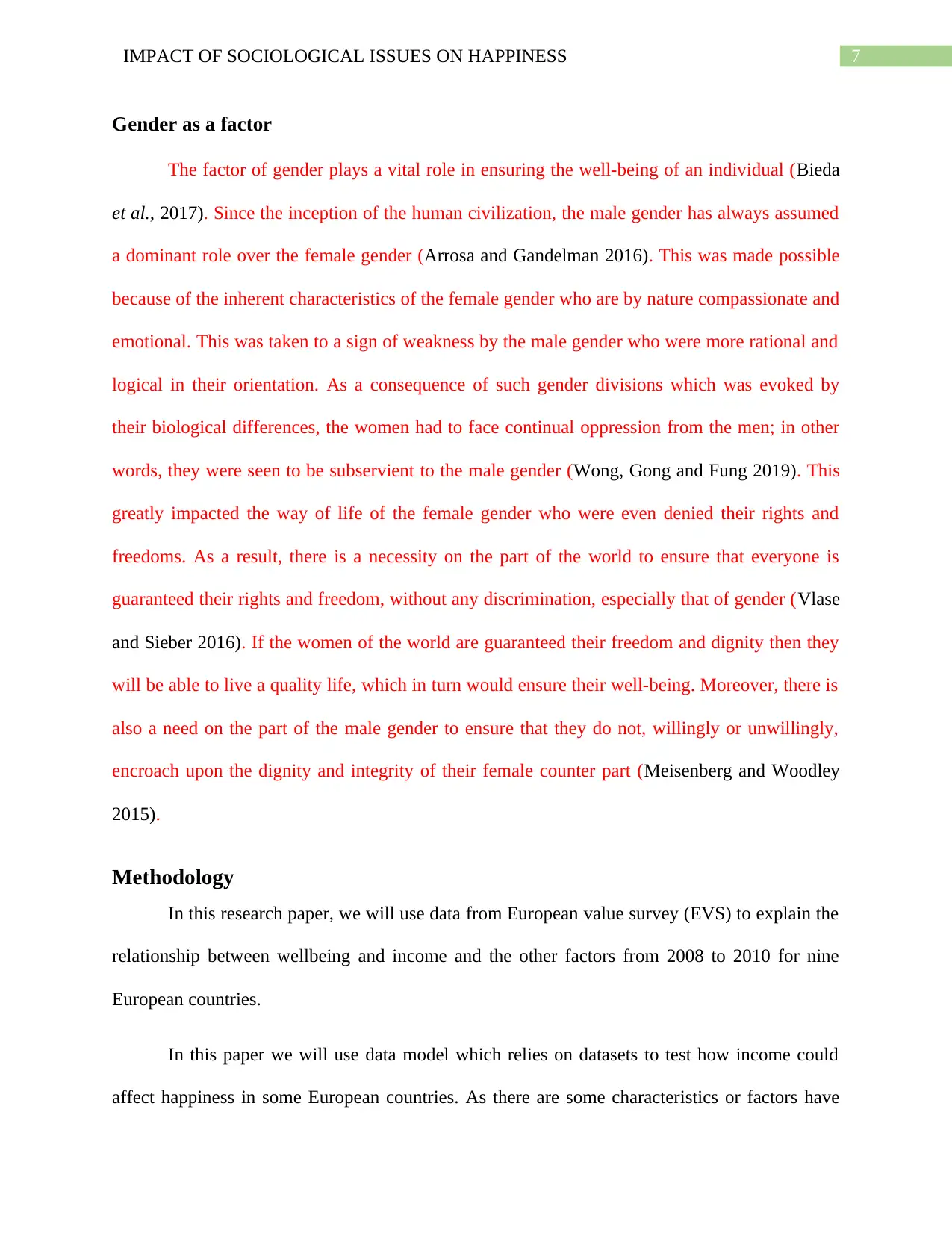
7IMPACT OF SOCIOLOGICAL ISSUES ON HAPPINESS
Gender as a factor
The factor of gender plays a vital role in ensuring the well-being of an individual (Bieda
et al., 2017). Since the inception of the human civilization, the male gender has always assumed
a dominant role over the female gender (Arrosa and Gandelman 2016). This was made possible
because of the inherent characteristics of the female gender who are by nature compassionate and
emotional. This was taken to a sign of weakness by the male gender who were more rational and
logical in their orientation. As a consequence of such gender divisions which was evoked by
their biological differences, the women had to face continual oppression from the men; in other
words, they were seen to be subservient to the male gender (Wong, Gong and Fung 2019). This
greatly impacted the way of life of the female gender who were even denied their rights and
freedoms. As a result, there is a necessity on the part of the world to ensure that everyone is
guaranteed their rights and freedom, without any discrimination, especially that of gender (Vlase
and Sieber 2016). If the women of the world are guaranteed their freedom and dignity then they
will be able to live a quality life, which in turn would ensure their well-being. Moreover, there is
also a need on the part of the male gender to ensure that they do not, willingly or unwillingly,
encroach upon the dignity and integrity of their female counter part (Meisenberg and Woodley
2015).
Methodology
In this research paper, we will use data from European value survey (EVS) to explain the
relationship between wellbeing and income and the other factors from 2008 to 2010 for nine
European countries.
In this paper we will use data model which relies on datasets to test how income could
affect happiness in some European countries. As there are some characteristics or factors have
Gender as a factor
The factor of gender plays a vital role in ensuring the well-being of an individual (Bieda
et al., 2017). Since the inception of the human civilization, the male gender has always assumed
a dominant role over the female gender (Arrosa and Gandelman 2016). This was made possible
because of the inherent characteristics of the female gender who are by nature compassionate and
emotional. This was taken to a sign of weakness by the male gender who were more rational and
logical in their orientation. As a consequence of such gender divisions which was evoked by
their biological differences, the women had to face continual oppression from the men; in other
words, they were seen to be subservient to the male gender (Wong, Gong and Fung 2019). This
greatly impacted the way of life of the female gender who were even denied their rights and
freedoms. As a result, there is a necessity on the part of the world to ensure that everyone is
guaranteed their rights and freedom, without any discrimination, especially that of gender (Vlase
and Sieber 2016). If the women of the world are guaranteed their freedom and dignity then they
will be able to live a quality life, which in turn would ensure their well-being. Moreover, there is
also a need on the part of the male gender to ensure that they do not, willingly or unwillingly,
encroach upon the dignity and integrity of their female counter part (Meisenberg and Woodley
2015).
Methodology
In this research paper, we will use data from European value survey (EVS) to explain the
relationship between wellbeing and income and the other factors from 2008 to 2010 for nine
European countries.
In this paper we will use data model which relies on datasets to test how income could
affect happiness in some European countries. As there are some characteristics or factors have
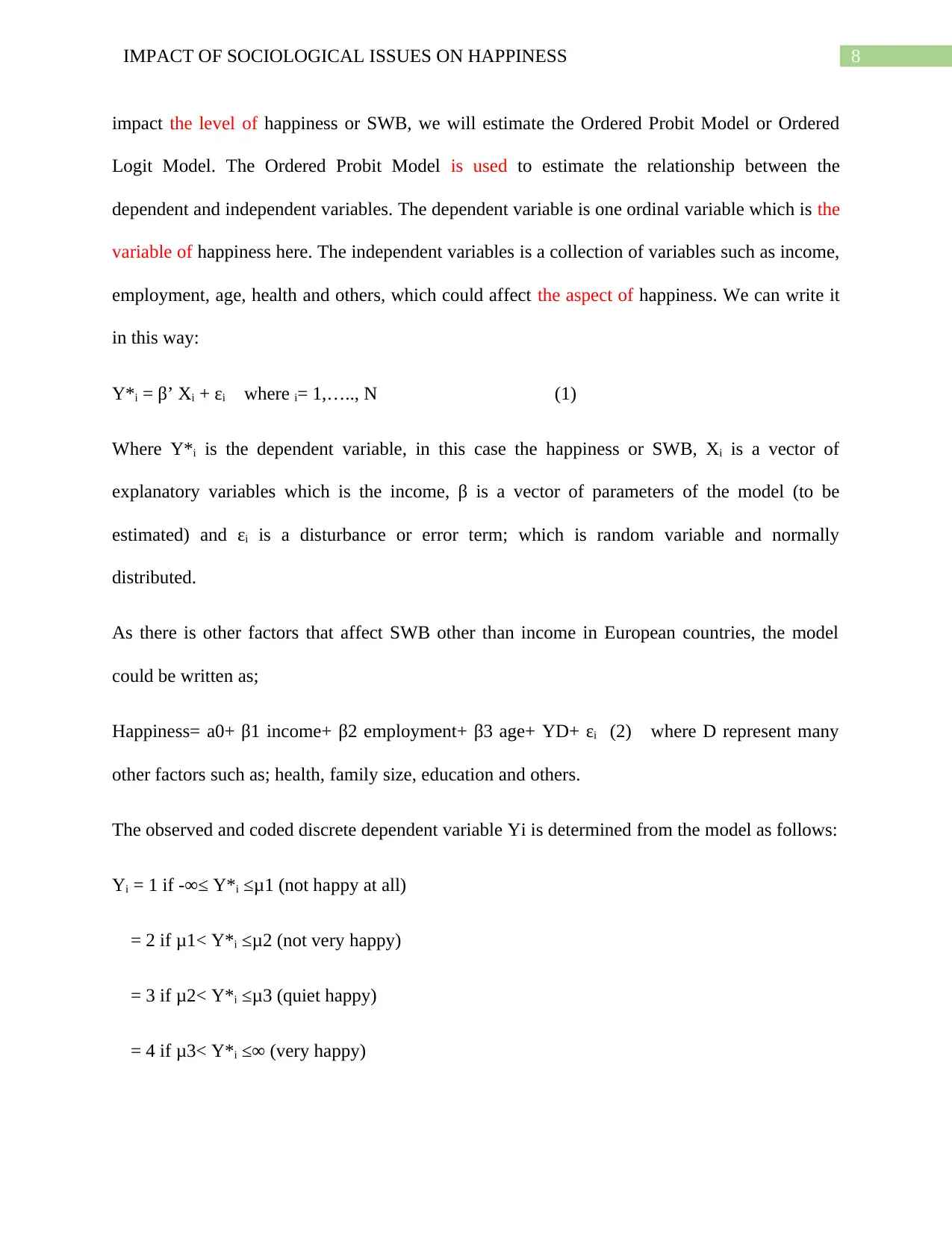
8IMPACT OF SOCIOLOGICAL ISSUES ON HAPPINESS
impact the level of happiness or SWB, we will estimate the Ordered Probit Model or Ordered
Logit Model. The Ordered Probit Model is used to estimate the relationship between the
dependent and independent variables. The dependent variable is one ordinal variable which is the
variable of happiness here. The independent variables is a collection of variables such as income,
employment, age, health and others, which could affect the aspect of happiness. We can write it
in this way:
Y*ᵢ = β’ Xᵢ + ɛᵢ where ᵢ= 1,….., N (1)
Where Y*ᵢ is the dependent variable, in this case the happiness or SWB, Xᵢ is a vector of
explanatory variables which is the income, β is a vector of parameters of the model (to be
estimated) and ɛᵢ is a disturbance or error term; which is random variable and normally
distributed.
As there is other factors that affect SWB other than income in European countries, the model
could be written as;
Happiness= a0+ β1 income+ β2 employment+ β3 age+ YD+ ɛᵢ (2) where D represent many
other factors such as; health, family size, education and others.
The observed and coded discrete dependent variable Yi is determined from the model as follows:
Yᵢ = 1 if -∞≤ Y*ᵢ ≤μ1 (not happy at all)
= 2 if μ1< Y*ᵢ ≤μ2 (not very happy)
= 3 if μ2< Y*ᵢ ≤μ3 (quiet happy)
= 4 if μ3< Y*ᵢ ≤∞ (very happy)
impact the level of happiness or SWB, we will estimate the Ordered Probit Model or Ordered
Logit Model. The Ordered Probit Model is used to estimate the relationship between the
dependent and independent variables. The dependent variable is one ordinal variable which is the
variable of happiness here. The independent variables is a collection of variables such as income,
employment, age, health and others, which could affect the aspect of happiness. We can write it
in this way:
Y*ᵢ = β’ Xᵢ + ɛᵢ where ᵢ= 1,….., N (1)
Where Y*ᵢ is the dependent variable, in this case the happiness or SWB, Xᵢ is a vector of
explanatory variables which is the income, β is a vector of parameters of the model (to be
estimated) and ɛᵢ is a disturbance or error term; which is random variable and normally
distributed.
As there is other factors that affect SWB other than income in European countries, the model
could be written as;
Happiness= a0+ β1 income+ β2 employment+ β3 age+ YD+ ɛᵢ (2) where D represent many
other factors such as; health, family size, education and others.
The observed and coded discrete dependent variable Yi is determined from the model as follows:
Yᵢ = 1 if -∞≤ Y*ᵢ ≤μ1 (not happy at all)
= 2 if μ1< Y*ᵢ ≤μ2 (not very happy)
= 3 if μ2< Y*ᵢ ≤μ3 (quiet happy)
= 4 if μ3< Y*ᵢ ≤∞ (very happy)
⊘ This is a preview!⊘
Do you want full access?
Subscribe today to unlock all pages.

Trusted by 1+ million students worldwide
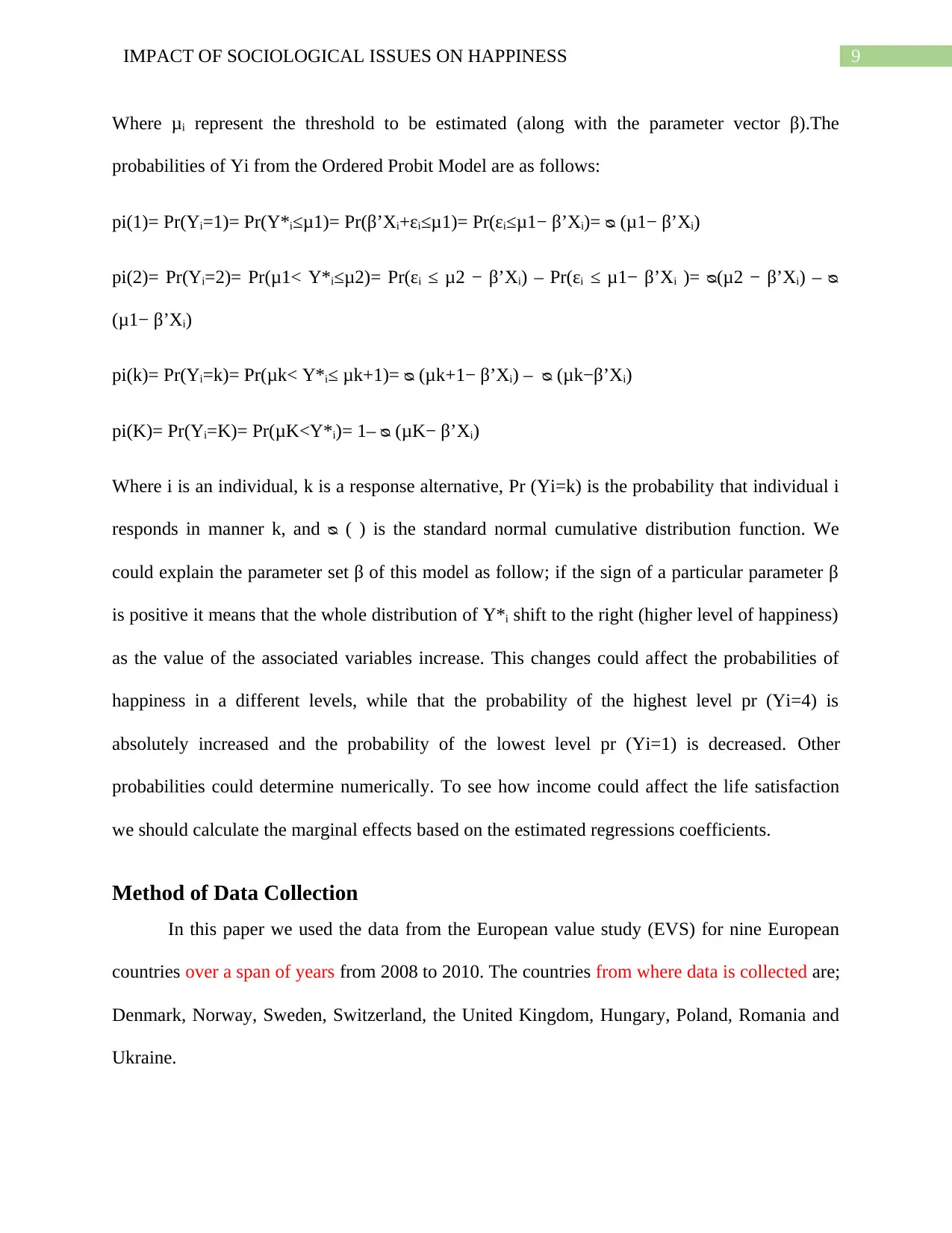
9IMPACT OF SOCIOLOGICAL ISSUES ON HAPPINESS
Where μᵢ represent the threshold to be estimated (along with the parameter vector β).The
probabilities of Yi from the Ordered Probit Model are as follows:
pi(1)= Pr(Yᵢ=1)= Pr(Y*ᵢ≤μ1)= Pr(β’Xᵢ+ɛᵢ≤μ1)= Pr(ɛᵢ≤μ1− β’Xᵢ)= ᴓ (μ1− β’Xᵢ)
pi(2)= Pr(Yᵢ=2)= Pr(μ1< Y*ᵢ≤μ2)= Pr(ɛᵢ ≤ μ2 − β’Xᵢ) – Pr(ɛᵢ ≤ μ1− β’Xᵢ )= ᴓ(μ2 − β’Xᵢ) – ᴓ
(μ1− β’Xᵢ)
pi(k)= Pr(Yᵢ=k)= Pr(μk< Y*ᵢ≤ μk+1)= ᴓ (μk+1− β’Xᵢ) – ᴓ (μk−β’Xᵢ)
pi(K)= Pr(Yᵢ=K)= Pr(μK<Y*ᵢ)= 1– ᴓ (μK− β’Xᵢ)
Where i is an individual, k is a response alternative, Pr (Yi=k) is the probability that individual i
responds in manner k, and ᴓ ( ) is the standard normal cumulative distribution function. We
could explain the parameter set β of this model as follow; if the sign of a particular parameter β
is positive it means that the whole distribution of Y*ᵢ shift to the right (higher level of happiness)
as the value of the associated variables increase. This changes could affect the probabilities of
happiness in a different levels, while that the probability of the highest level pr (Yi=4) is
absolutely increased and the probability of the lowest level pr (Yi=1) is decreased. Other
probabilities could determine numerically. To see how income could affect the life satisfaction
we should calculate the marginal effects based on the estimated regressions coefficients.
Method of Data Collection
In this paper we used the data from the European value study (EVS) for nine European
countries over a span of years from 2008 to 2010. The countries from where data is collected are;
Denmark, Norway, Sweden, Switzerland, the United Kingdom, Hungary, Poland, Romania and
Ukraine.
Where μᵢ represent the threshold to be estimated (along with the parameter vector β).The
probabilities of Yi from the Ordered Probit Model are as follows:
pi(1)= Pr(Yᵢ=1)= Pr(Y*ᵢ≤μ1)= Pr(β’Xᵢ+ɛᵢ≤μ1)= Pr(ɛᵢ≤μ1− β’Xᵢ)= ᴓ (μ1− β’Xᵢ)
pi(2)= Pr(Yᵢ=2)= Pr(μ1< Y*ᵢ≤μ2)= Pr(ɛᵢ ≤ μ2 − β’Xᵢ) – Pr(ɛᵢ ≤ μ1− β’Xᵢ )= ᴓ(μ2 − β’Xᵢ) – ᴓ
(μ1− β’Xᵢ)
pi(k)= Pr(Yᵢ=k)= Pr(μk< Y*ᵢ≤ μk+1)= ᴓ (μk+1− β’Xᵢ) – ᴓ (μk−β’Xᵢ)
pi(K)= Pr(Yᵢ=K)= Pr(μK<Y*ᵢ)= 1– ᴓ (μK− β’Xᵢ)
Where i is an individual, k is a response alternative, Pr (Yi=k) is the probability that individual i
responds in manner k, and ᴓ ( ) is the standard normal cumulative distribution function. We
could explain the parameter set β of this model as follow; if the sign of a particular parameter β
is positive it means that the whole distribution of Y*ᵢ shift to the right (higher level of happiness)
as the value of the associated variables increase. This changes could affect the probabilities of
happiness in a different levels, while that the probability of the highest level pr (Yi=4) is
absolutely increased and the probability of the lowest level pr (Yi=1) is decreased. Other
probabilities could determine numerically. To see how income could affect the life satisfaction
we should calculate the marginal effects based on the estimated regressions coefficients.
Method of Data Collection
In this paper we used the data from the European value study (EVS) for nine European
countries over a span of years from 2008 to 2010. The countries from where data is collected are;
Denmark, Norway, Sweden, Switzerland, the United Kingdom, Hungary, Poland, Romania and
Ukraine.
Paraphrase This Document
Need a fresh take? Get an instant paraphrase of this document with our AI Paraphraser
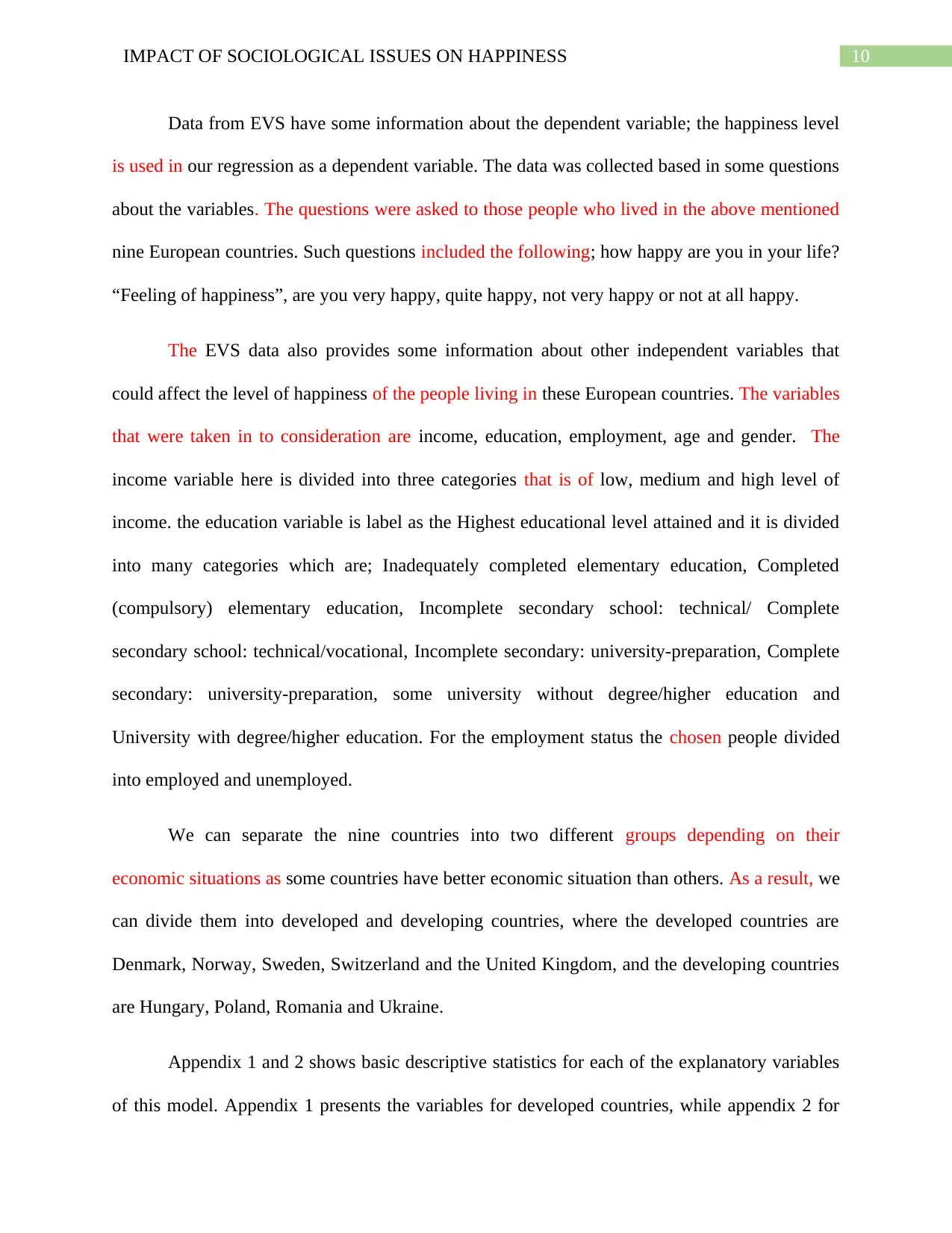
10IMPACT OF SOCIOLOGICAL ISSUES ON HAPPINESS
Data from EVS have some information about the dependent variable; the happiness level
is used in our regression as a dependent variable. The data was collected based in some questions
about the variables. The questions were asked to those people who lived in the above mentioned
nine European countries. Such questions included the following; how happy are you in your life?
“Feeling of happiness”, are you very happy, quite happy, not very happy or not at all happy.
The EVS data also provides some information about other independent variables that
could affect the level of happiness of the people living in these European countries. The variables
that were taken in to consideration are income, education, employment, age and gender. The
income variable here is divided into three categories that is of low, medium and high level of
income. the education variable is label as the Highest educational level attained and it is divided
into many categories which are; Inadequately completed elementary education, Completed
(compulsory) elementary education, Incomplete secondary school: technical/ Complete
secondary school: technical/vocational, Incomplete secondary: university-preparation, Complete
secondary: university-preparation, some university without degree/higher education and
University with degree/higher education. For the employment status the chosen people divided
into employed and unemployed.
We can separate the nine countries into two different groups depending on their
economic situations as some countries have better economic situation than others. As a result, we
can divide them into developed and developing countries, where the developed countries are
Denmark, Norway, Sweden, Switzerland and the United Kingdom, and the developing countries
are Hungary, Poland, Romania and Ukraine.
Appendix 1 and 2 shows basic descriptive statistics for each of the explanatory variables
of this model. Appendix 1 presents the variables for developed countries, while appendix 2 for
Data from EVS have some information about the dependent variable; the happiness level
is used in our regression as a dependent variable. The data was collected based in some questions
about the variables. The questions were asked to those people who lived in the above mentioned
nine European countries. Such questions included the following; how happy are you in your life?
“Feeling of happiness”, are you very happy, quite happy, not very happy or not at all happy.
The EVS data also provides some information about other independent variables that
could affect the level of happiness of the people living in these European countries. The variables
that were taken in to consideration are income, education, employment, age and gender. The
income variable here is divided into three categories that is of low, medium and high level of
income. the education variable is label as the Highest educational level attained and it is divided
into many categories which are; Inadequately completed elementary education, Completed
(compulsory) elementary education, Incomplete secondary school: technical/ Complete
secondary school: technical/vocational, Incomplete secondary: university-preparation, Complete
secondary: university-preparation, some university without degree/higher education and
University with degree/higher education. For the employment status the chosen people divided
into employed and unemployed.
We can separate the nine countries into two different groups depending on their
economic situations as some countries have better economic situation than others. As a result, we
can divide them into developed and developing countries, where the developed countries are
Denmark, Norway, Sweden, Switzerland and the United Kingdom, and the developing countries
are Hungary, Poland, Romania and Ukraine.
Appendix 1 and 2 shows basic descriptive statistics for each of the explanatory variables
of this model. Appendix 1 presents the variables for developed countries, while appendix 2 for
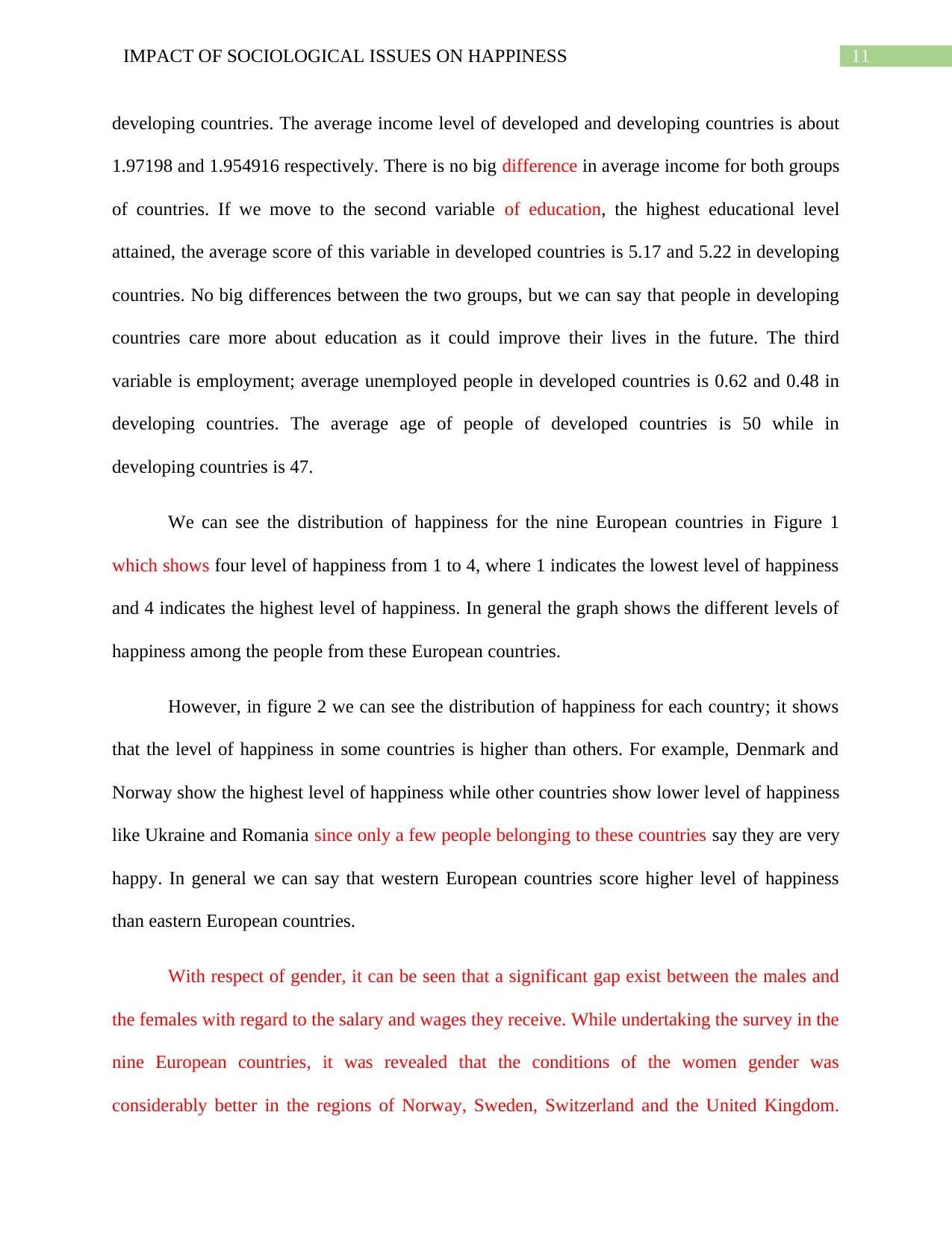
11IMPACT OF SOCIOLOGICAL ISSUES ON HAPPINESS
developing countries. The average income level of developed and developing countries is about
1.97198 and 1.954916 respectively. There is no big difference in average income for both groups
of countries. If we move to the second variable of education, the highest educational level
attained, the average score of this variable in developed countries is 5.17 and 5.22 in developing
countries. No big differences between the two groups, but we can say that people in developing
countries care more about education as it could improve their lives in the future. The third
variable is employment; average unemployed people in developed countries is 0.62 and 0.48 in
developing countries. The average age of people of developed countries is 50 while in
developing countries is 47.
We can see the distribution of happiness for the nine European countries in Figure 1
which shows four level of happiness from 1 to 4, where 1 indicates the lowest level of happiness
and 4 indicates the highest level of happiness. In general the graph shows the different levels of
happiness among the people from these European countries.
However, in figure 2 we can see the distribution of happiness for each country; it shows
that the level of happiness in some countries is higher than others. For example, Denmark and
Norway show the highest level of happiness while other countries show lower level of happiness
like Ukraine and Romania since only a few people belonging to these countries say they are very
happy. In general we can say that western European countries score higher level of happiness
than eastern European countries.
With respect of gender, it can be seen that a significant gap exist between the males and
the females with regard to the salary and wages they receive. While undertaking the survey in the
nine European countries, it was revealed that the conditions of the women gender was
considerably better in the regions of Norway, Sweden, Switzerland and the United Kingdom.
developing countries. The average income level of developed and developing countries is about
1.97198 and 1.954916 respectively. There is no big difference in average income for both groups
of countries. If we move to the second variable of education, the highest educational level
attained, the average score of this variable in developed countries is 5.17 and 5.22 in developing
countries. No big differences between the two groups, but we can say that people in developing
countries care more about education as it could improve their lives in the future. The third
variable is employment; average unemployed people in developed countries is 0.62 and 0.48 in
developing countries. The average age of people of developed countries is 50 while in
developing countries is 47.
We can see the distribution of happiness for the nine European countries in Figure 1
which shows four level of happiness from 1 to 4, where 1 indicates the lowest level of happiness
and 4 indicates the highest level of happiness. In general the graph shows the different levels of
happiness among the people from these European countries.
However, in figure 2 we can see the distribution of happiness for each country; it shows
that the level of happiness in some countries is higher than others. For example, Denmark and
Norway show the highest level of happiness while other countries show lower level of happiness
like Ukraine and Romania since only a few people belonging to these countries say they are very
happy. In general we can say that western European countries score higher level of happiness
than eastern European countries.
With respect of gender, it can be seen that a significant gap exist between the males and
the females with regard to the salary and wages they receive. While undertaking the survey in the
nine European countries, it was revealed that the conditions of the women gender was
considerably better in the regions of Norway, Sweden, Switzerland and the United Kingdom.
⊘ This is a preview!⊘
Do you want full access?
Subscribe today to unlock all pages.

Trusted by 1+ million students worldwide
1 out of 30
Related Documents
Your All-in-One AI-Powered Toolkit for Academic Success.
+13062052269
info@desklib.com
Available 24*7 on WhatsApp / Email
![[object Object]](/_next/static/media/star-bottom.7253800d.svg)
Unlock your academic potential
Copyright © 2020–2025 A2Z Services. All Rights Reserved. Developed and managed by ZUCOL.





